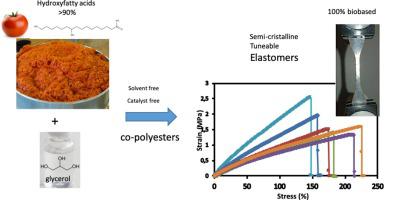Industrial Crops and Products ( IF 5.9 ) Pub Date : 2021-06-17 , DOI: 10.1016/j.indcrop.2021.113718 Mathilde Marc , Regis Risani , Eric Desnoes , Xavier Falourd , Bruno Pontoire , Rúben Rodrigues , Rita Escórcio , Ana Paula Batista , Romain Valentin , Nathalie Gontard , Cristina Silva Pereira , Christelle Lopez , Eric Leroy , Denis Lourdin , Didier Marion , Bénédicte Bakan

|
By mimicking the cutin natural polyester networks of plant cuticles, we produced hydrophobic elastomers by a sustainable process, i.e., using a catalyst- and solvent-free polycondensation of glycerol and hydroxy fatty acids, two by-products of the agro-food industry. The hydroxy fatty acid fraction was obtained by ethanolic alkaline hydrolysis of cuticle from industrial tomato. This industrial-like fatty acid fraction contained more than 90 wt%. of 9(10),16 dihydroxyhexadecanoic acid (diOHC16). The co-polyesters were designed by increasing the ratio of esterified glycerol/diOHC16 in a range observed in plant cutins (up to 6 wt%). Their structure and functional properties (thermal, mechanical, gas permeability, interaction with bacterial cells) were characterized. Increasing the glycerol contents induced a significant decrease in the crosslink density of the polyesters and the formation of crystalline domains with a hexagonal organization. These structural modifications were related to a marked increase of elastomeric extensibility (up to 217 %). While water vapor permeability was not impacted, the increase of glycerol content induced a significant decrease in oxygen permeability. None of the polyesters displayed biocide activity, but an increase of glycerol content significantly reduced the adhesion of bacterial cells, potentially giving rise to antifouling applications.
中文翻译:

从番茄皮农业废弃物和甘油中提取的羟基脂肪酸的仿生共聚酯具有可调的机械、热和阻隔性能
通过模仿植物角质层的角质天然聚酯网络,我们通过可持续的过程生产疏水性弹性体,即使用甘油和羟基脂肪酸的无催化剂和无溶剂缩聚反应,这是农业食品工业的两种副产品。羟基脂肪酸部分是通过乙醇碱水解工业番茄的角质层获得的。这种类似工业的脂肪酸馏分含有超过 90%(重量)。9(10),16 二羟基十六烷酸 (diOHC16)。通过在植物角质中观察到的范围内增加酯化甘油/diOHC16 的比例(高达 6 wt%)来设计共聚酯。表征了它们的结构和功能特性(热、机械、气体渗透性、与细菌细胞的相互作用)。增加甘油含量导致聚酯交联密度的显着降低和具有六边形组织的结晶域的形成。这些结构修改与弹性体延伸性的显着增加(高达 217%)有关。虽然水蒸气渗透率没有受到影响,但甘油含量的增加导致氧渗透率的显着降低。没有一种聚酯显示出杀生物活性,但甘油含量的增加显着降低了细菌细胞的粘附,可能会引起防污应用。虽然水蒸气渗透率没有受到影响,但甘油含量的增加导致氧渗透率的显着降低。没有一种聚酯显示出杀生物活性,但甘油含量的增加显着降低了细菌细胞的粘附,可能会引起防污应用。虽然水蒸气渗透率没有受到影响,但甘油含量的增加导致氧渗透率的显着降低。没有一种聚酯显示出杀生物活性,但甘油含量的增加显着降低了细菌细胞的粘附,可能会引起防污应用。

























 京公网安备 11010802027423号
京公网安备 11010802027423号